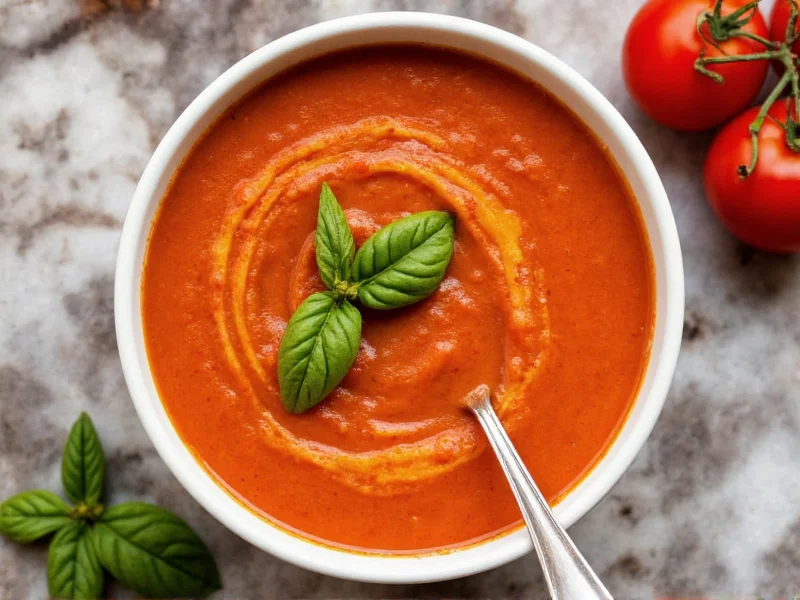The Science Behind Roasting Tomatoes
When tomatoes roast at high heat (400°F/200°C), several chemical reactions occur that dramatically improve flavor. The Maillard reaction creates new flavor compounds while caramelization concentrates natural sugars. Water evaporates, intensifying tomato essence without requiring reduction time. Roasting also breaks down cell walls, releasing more lycopene—a powerful antioxidant—than raw or boiled tomatoes. This process creates a deeper, more complex foundation for your soup compared to traditional stovetop methods.
Choosing the Right Tomatoes
Not all tomatoes work equally well for roasting. Here's how to select the best varieties:
| Tomato Variety | Best For Roasting? | Flavor Profile | Moisture Content |
|---|---|---|---|
| Roma/Plum | ✓ Excellent | Rich, concentrated | Low (ideal for roasting) |
| Cherry | ✓ Excellent | Sweet, intense | Medium |
| Beefsteak | △ Acceptable | Milder, less complex | High (requires longer roasting) |
| Garden Slices | ✗ Poor | Watery, bland | Very high |
Roma tomatoes remain the professional chef's preferred choice for roasted tomato basil soup due to their lower moisture content and higher flesh-to-liquid ratio. When in season, heirloom varieties like San Marzano or Amish Paste provide exceptional depth of flavor. Avoid watery supermarket tomatoes typically sold for sandwiches—they lack sufficient sugar content for proper caramelization.
Essential Ingredients Breakdown
The magic of roasted tomato basil soup comes from minimal ingredients executed perfectly:
- Tomatoes: 3 lbs (1.4 kg) Roma or similar meaty variety, halved lengthwise
- Fresh basil: 1 cup packed leaves (not stems), added at the end for brightness
- Garlic: 5-6 cloves, roasted alongside tomatoes for sweet depth
- Olive oil: Extra virgin for roasting, regular for soup base (high heat)
- Onion: 1 medium yellow, for aromatic foundation
- Vegetable broth: Low-sodium, 2 cups (homemade preferred)
- Baking soda: Tiny pinch (1/16 tsp) to neutralize acidity without sweetness
For a creamy roasted tomato basil soup without cream, blend in 1/4 cup raw cashews during processing. This creates luxurious texture while keeping the soup dairy-free and vegan. Avoid heavy cream which masks the delicate roasted tomato flavor.
Step-by-Step Roasting Process
Follow these precise steps for perfect roasted tomato basil soup every time:
- Preheat oven to 400°F (205°C) with rack in upper third position
- Prepare tomatoes: Halve Roma tomatoes lengthwise, remove seeds if desired
- Arrange cut-side up on parchment-lined baking sheet
- Drizzle with 2 tbsp olive oil, sprinkle with 1 tsp sea salt and 1/2 tsp black pepper
- Add unpeeled garlic cloves between tomatoes
- Roast 40-45 minutes until edges char and liquid evaporates
- Cool slightly, then remove garlic skins
- Sauté onion in 1 tbsp oil until translucent (5-7 minutes)
- Combine roasted tomatoes, garlic, onion, broth, and basil in blender
- Blend until completely smooth (2-3 minutes)
- Return to pot, add baking soda pinch, simmer 10 minutes
Pro Techniques for Restaurant-Quality Results
Amateur soup makers often miss these critical details that separate good from exceptional roasted tomato basil soup:
- Seed removal: Scoop out gel and seeds from larger tomatoes to prevent bitterness
- Char control: Rotate pan halfway through roasting for even caramelization
- Cooling time: Let tomatoes rest 10 minutes before blending for safer processing
- Blending temperature: Process while warm (not hot) to prevent steam explosions
- Final seasoning: Adjust salt after soup simmers—roasting concentrates flavors
For the best tomatoes for roasted tomato soup, use seasonal produce at peak ripeness. During off-season, high-quality canned San Marzano tomatoes make an acceptable substitute—drain and roast them anyway to develop flavor.
Serving and Storage Guidelines
Proper presentation and storage preserve your soup's quality:
- Serving temperature: 165-180°F (74-82°C)—too hot masks subtle flavors
- Garnish: Fresh basil chiffonade, drizzle of basil oil, or roasted tomato seeds
- Accompaniments: Crusty bread, grilled cheese, or arugula salad
- Refrigeration: Store in airtight container up to 4 days
- Freezing: Portion in freezer bags (lay flat), keeps 6 months
When reheating, do so gently over medium-low heat. Boiling destroys delicate basil notes. For frozen soup, thaw overnight in refrigerator before reheating. These roasted tomato basil soup storage tips maintain flavor integrity far better than most home cooks realize.
Variations Worth Trying
Once you've mastered the easy roasted tomato basil soup recipe, experiment with these professional variations:
- Roasted red pepper version: Add 1 large roasted red pepper for smoky sweetness
- Spicy arrabbiata style: Include 1/2 tsp red pepper flakes with onions
- Umami boost: Add 1 dried porcini mushroom while roasting tomatoes
- Citrus twist: Finish with 1 tsp lemon zest to brighten flavors
- Creamy alternative: Blend in 1/4 avocado instead of dairy for richness
For a healthy roasted tomato basil soup, reduce added salt by 25% and increase roasted garlic. The natural sweetness compensates while boosting immune-supporting compounds. This approach creates a nutrient-dense meal under 200 calories per serving.
Troubleshooting Common Issues
Even experienced cooks encounter these problems with roasted tomato soup:
- Too acidic: Add 1/16 tsp baking soda (not sugar) to neutralize without sweetness
- Too thin: Simmer uncovered 5-10 minutes to reduce, or add roasted tomato paste
- Bland flavor: Under-roasted tomatoes—extend roasting time by 10-15 minutes
- Bitter notes: Over-charred tomatoes—next time reduce oven temperature by 25°F
- Separation: Blend longer (3+ minutes) to fully emulsify ingredients
Remember that basil loses its vibrant flavor when overcooked. Always add fresh basil after roasting and blend it in at the end for that signature roasted tomato soup with fresh basil aroma. Dried basil makes an acceptable substitute in winter months—use 1 tbsp dried for every 1 cup fresh.











 浙公网安备
33010002000092号
浙公网安备
33010002000092号 浙B2-20120091-4
浙B2-20120091-4